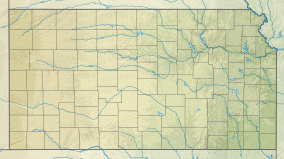| Kanopolis State Park | |
|---|---|
 | |
Location of Kanopolis State Park in Ellsworth County, Kansas | |
| Location | Ellsworth, Kansas, United States |
| Coordinates | 38°39′26″N 97°59′59″W / 38.65722°N 97.99972°W |
| Elevation | 1,506 ft (459 m)[1] |
| Visitors | 290,436 (in 2022)[2] |
| Governing body | Kansas Department of Wildlife, Parks and Tourism |
Kanopolis State Park contains a reservoir, desert plants such as yucca, a prairie dog town, and scenic sandstone canyons. It is located in the Smoky Hills region of the U.S. state of Kansas. The park is located southwest of the city of Salina, just south of I-70.
The park, completed in 1948, includes more than 22,000 acres (89 km2) of rolling hills, bluffs and woods and a 3000 acre (12 km2) lake, offering hunting, fishing, over 25 miles (40 km) of trails, and other recreational activities. Game includes pheasant, quail, prairie chickens, deer, beaver, wild turkey, squirrels, rabbits, coyotes and waterfowl; fishing for white bass and crappie is popular. A small, outlier population of western diamondback rattlesnake is present in the park.
Park attractions[edit]
The following are components of Kanopolis State Park recreation area:
- Kanopolis Lake
- Mushroom Rock State Park
- Faris Caves
- Smoky Hill Wildlife Area
- Horsethief Canyon
See also[edit]
References[edit]
- ^ "Kanopolis State Park". Geographic Names Information System. United States Geological Survey. October 13, 1978. Retrieved December 2, 2012.
- ^ Self, Matthew (August 18, 2023). "Top 5 most popular Kansas state parks revealed". KSNT.



Well, that’s interesting to know that Psilotum nudum are known as whisk ferns. Psilotum nudum is the commoner species of the two. While the P. flaccidum is a rare species and is found in the tropical islands. Both the species are usually epiphytic in habit and grow upon tree ferns. These species may also be terrestrial and grow in humus or in the crevices of the rocks.
View the detailed Guide of Psilotum nudum: Detailed Study Of Psilotum Nudum (Whisk Fern), Classification, Anatomy, Reproduction